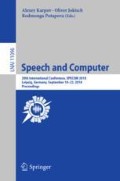Abstract
As technical systems around us aim at a more natural interaction, the task of automatic emotion recognition from speech receives an ever growing attention. One important question still remains unresolved: The definition of the most suitable features across different data types. In the present paper, we employed a random-forest based feature selection known from other research fields in order to select the most important features for three benchmark datasets. Investigating feature selection on the same corpus as well as across corpora, we achieved an increase in performance using only 40 to 60% of the features of the well-known emobase feature set.
Access this chapter
Tax calculation will be finalised at checkout
Purchases are for personal use only
References
Berthold, M.R., et al.: KNIME: The konstanz information miner. In: Preisach, C., Burkhardt, H., Schmidt-Thieme, L., Decker, R. (eds.) Data Analysis, Machine Learning and Applications. Studies in Classification, Data Analysis, and Knowledge Organization. Springer, Heidelberg (2008). https://doi.org/10.1007/978-3-540-78246-9_38
Bitouk, D., Verma, R., Nenkova, A.: Class-level spectral features for emotion recognition. Speech Commun. 52(7–8), 613–625 (2010)
Böck, R., Egorow, O., Siegert, I., Wendemuth, A.: Comparative study on normalisation in emotion recognition from speech. In: Horain, P., Achard, C., Mallem, M. (eds.) IHCI 2017. LNCS, vol. 10688, pp. 189–201. Springer, Cham (2017). https://doi.org/10.1007/978-3-319-72038-8_15
Breiman, L.: Random forests. Mach. Learn. 45(1), 5–32 (2001)
Burkhardt, F., Paeschke, A., Rolfes, M., Sendlmeier, W., Weiss, B.: A database of German emotional speech. In: Proceedings of the INTERSPEECH-2005, pp. 1517–1520 (2005)
Chang, C.C., Lin, C.J.: LIBSVM: a library for support vector machines. Trans. Intell. Syst. Technol. 2, 1–27 (2011)
Chen, Y.W., Lin, C.J.: Combining SVMs with various feature selection strategies. In: Guyon, I., Nikravesh, M., Gunn, S., Zadeh, L.A. (eds.) Feature Extraction: Foundations and Applications, pp. 315–324. Springer, Berlin Heidelberg (2006). https://doi.org/10.1007/978-3-540-35488-8_13
Egorow, O., Wendemuth, A.: Detection of challenging dialogue stages using acoustic signals and biosignals. In: Proceedings of the 24th International Conference on Computer Graphics, Visualization and Computer Vision, pp. 137–143 (2016)
Eyben, F., et al.: The geneva minimalistic acoustic parameter set (GeMAPS) for voice research and affective computing. Trans. Affect. Comput. 7(2), 190–202 (2016)
Eyben, F., Wöllmer, M., Schuller, B.: OpenEAR - introducing the Munich open-source emotion and affect recognition toolkit. In: Proceedings of the 3rd International Conference on Affective Computing and Intelligent Interaction (ACII), pp. 1–6. IEEE (2009)
Gharavian, D., Sheikhan, M., Nazerieh, A., Garoucy, S.: Speech emotion recognition using FCBF feature selection method and GA-optimized fuzzy ARTMAP neural network. Neural Comput. Appl. 21(8), 2115–2126 (2012)
Hansen, J., Bou-Ghazale, S.: Getting started with SUSAS: A speech under simulated and actual stress database. In: Proceedings of the EUROSPEECH-1997, pp. 1743–1746 (1997)
Kwon, O.W., Chan, K., Hao, J., Lee, T.W.: Emotion recognition by speech signals. In: Proceedings of the 8th European Conference on Speech Communication and Technology (2003)
Levinson, S.C., Holler, J.: The origin of human multi-modal communication. Phil. Trans. R. Soc. B 369(1651), 20130302 (2014)
Mao, Q., Zhao, X., Zhan, Y.: Extraction and analysis for non-personalized emotion features of speech. Adv. Inf. Sci. Serv. Sci. 3(10), 255–263 (2011)
Menze, B.H., et al.: A comparison of random forest and its Gini importance with standard chemometric methods for the feature selection and classification of spectral data. BMC Bioinformatics 10(1), 213 (2009)
Oshrat, Y., Bloch, A., Lerner, A., Cohen, A., Avigal, M., Zeilig, G.: Speech prosody as a biosignal for physical pain detection. In: Proceedings of Speech Prosody, pp. 420–424 (2016)
Palo, H.K., Mohanty, M.N.: Wavelet based feature combination for recognition of emotions. Ain Shams Eng. J. (2017, in Press)
Ramanarayanan, V., et al.: Using vision and speech features for automated prediction of performance metrics in multimodal dialogs. ETS Research Report Series 1 (2017)
Schuller, B., Müller, R., Hörnler, B., Höthker, A., Konosu, H., Rigoll, G.: Audiovisual recognition of spontaneous interest within conversations. In: Proceedings of the 9th International Conference on Multimodal interfaces, pp. 30–37. ACM (2007)
Schuller, B., Batliner, A., Steidl, S., Seppi, D.: Recognising realistic emotions and affect in speech: state of the art and lessons learnt from the first challenge. Speech Commun. 53(9–10), 1062–1087 (2011)
Schuller, B., Wöllmer, M., Eyben, F., Rigoll, G.: The role of prosody in affective speech, linguistic insights, studies in language and communication. Lang. Commun. 97, 285–307 (2009)
Silipo, R., Adae, I., Hart, A., Berthold, M.: Seven techniques for dimensionality reduction. Technical report, KNIME (2014)
Tzirakis, P., Trigeorgis, G., Nicolaou, M.A., Schuller, B.W., Zafeiriou, S.: End-to-end multimodal emotion recognition using deep neural networks. J. Sel. Top. Signal Process. 11(8), 1301–1309 (2017)
Wang, K., An, N., Li, B.N., Zhang, Y., Li, L.: Speech emotion recognition using fourier parameters. Trans. Affect. Comput. 6(1), 69–75 (2015)
Yang, C., Ji, L., Liu, G.: Study to speech emotion recognition based on TWINsSVM. In: Proceedings of the 5th International Conference on Natural Computation, vol. 2, pp. 312–316. IEEE (2009)
Acknowledgements
This work has been sponsored by the German Federal Ministry of Education and Research in the program Zwanzig20 – Partnership for Innovation as part of the research alliance 3Dsensation (grant number 03ZZ0414). It was also supported by the project Intention-based Anticipatory Interactive Systems (IAIS) funded by the European Funds for Regional Development (EFRE) and by the Federal State of Sachsen-Anhalt, Germany (grant number ZS/2017/10/88785).
Author information
Authors and Affiliations
Corresponding author
Editor information
Editors and Affiliations
Rights and permissions
Copyright information
© 2018 Springer Nature Switzerland AG
About this paper
Cite this paper
Egorow, O., Siegert, I., Wendemuth, A. (2018). Improving Emotion Recognition Performance by Random-Forest-Based Feature Selection. In: Karpov, A., Jokisch, O., Potapova, R. (eds) Speech and Computer. SPECOM 2018. Lecture Notes in Computer Science(), vol 11096. Springer, Cham. https://doi.org/10.1007/978-3-319-99579-3_15
Download citation
DOI: https://doi.org/10.1007/978-3-319-99579-3_15
Published:
Publisher Name: Springer, Cham
Print ISBN: 978-3-319-99578-6
Online ISBN: 978-3-319-99579-3
eBook Packages: Computer ScienceComputer Science (R0)

